Comprehensive Report on Management Accounting in Business Operations
VerifiedAdded on 2020/10/05
|19
|6061
|158
Report
AI Summary
This report provides a comprehensive overview of management accounting, covering its fundamentals, types, and applications in a business environment. It delves into the importance of management accounting for managerial decisions, differentiating it from financial accounting and exploring various systems like cost accounting, inventory management, job costing, and price optimization. The report also examines different methods of management accounting reporting, including cost reports, budget reports, and performance reports, highlighting their roles in financial analysis and decision-making. Furthermore, it discusses the implications of suitable costing methods, such as marginal costing and absorption costing, for preparing income statements. The report includes an analysis of planning tools used for budgetary control, a SWOT analysis of a company, and a discussion on benchmarks, key performance indicators, and variance analysis, providing valuable insights into financial and non-financial aspects of business operations.
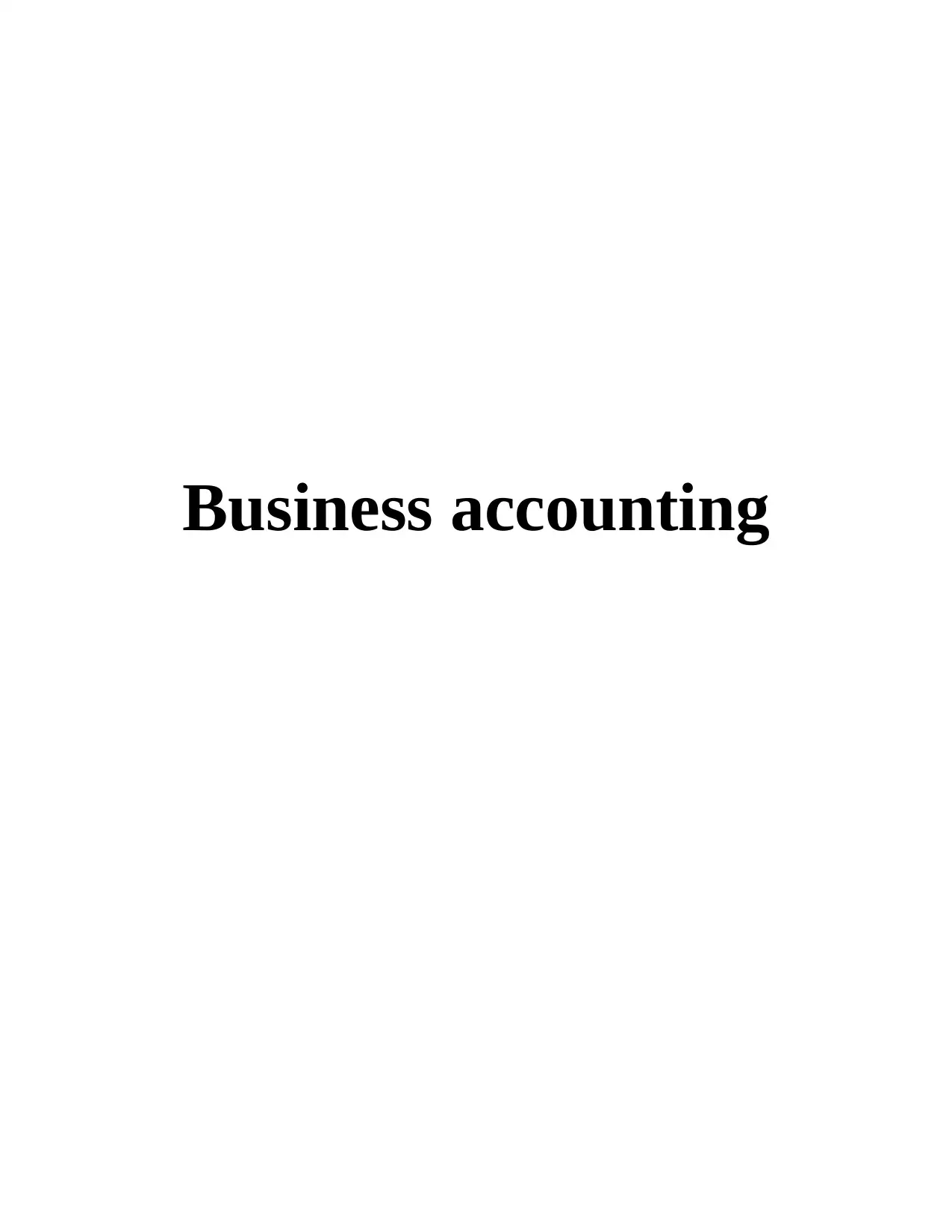
Business accounting
Paraphrase This Document
Need a fresh take? Get an instant paraphrase of this document with our AI Paraphraser
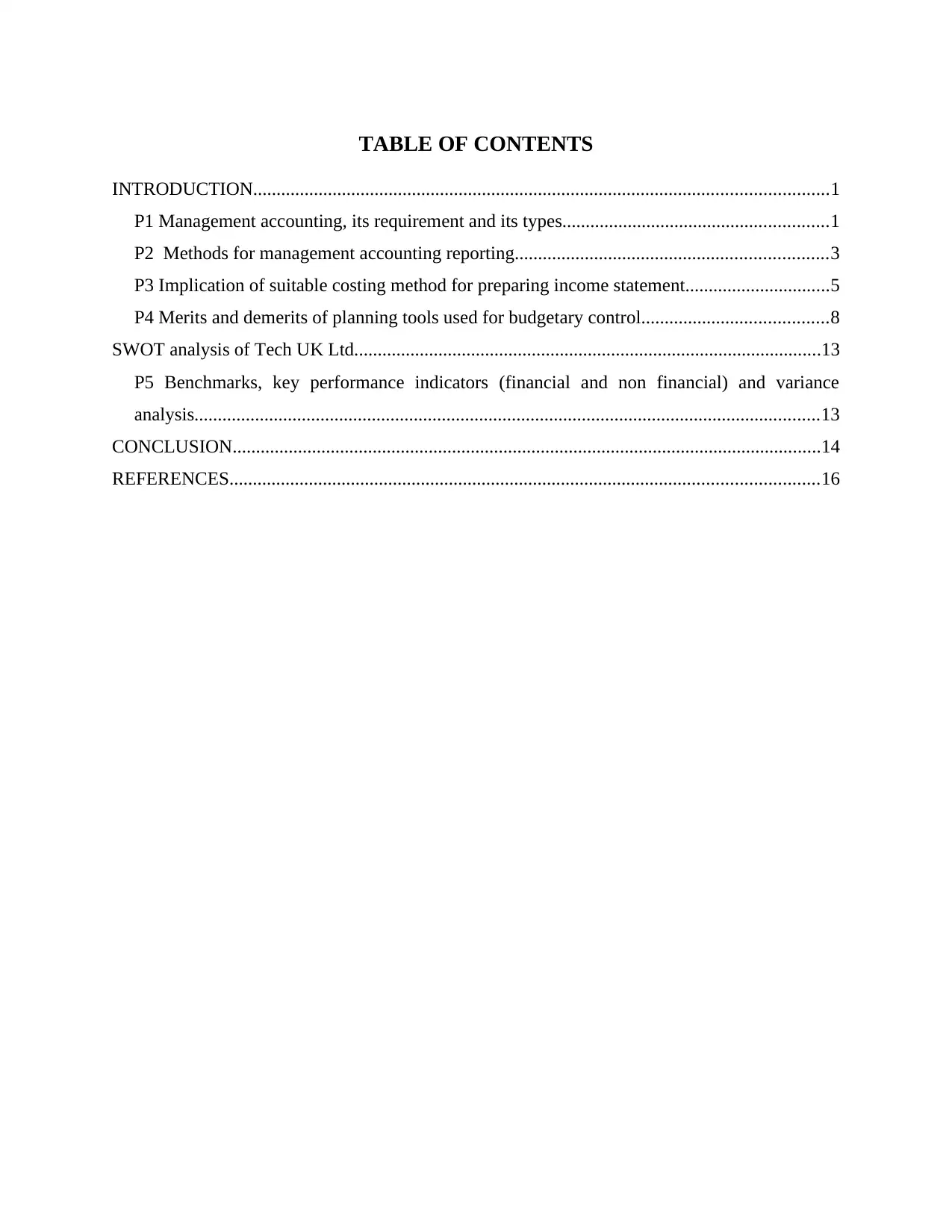
TABLE OF CONTENTS
INTRODUCTION...........................................................................................................................1
P1 Management accounting, its requirement and its types.........................................................1
P2 Methods for management accounting reporting...................................................................3
P3 Implication of suitable costing method for preparing income statement...............................5
P4 Merits and demerits of planning tools used for budgetary control........................................8
SWOT analysis of Tech UK Ltd....................................................................................................13
P5 Benchmarks, key performance indicators (financial and non financial) and variance
analysis......................................................................................................................................13
CONCLUSION..............................................................................................................................14
REFERENCES..............................................................................................................................16
INTRODUCTION...........................................................................................................................1
P1 Management accounting, its requirement and its types.........................................................1
P2 Methods for management accounting reporting...................................................................3
P3 Implication of suitable costing method for preparing income statement...............................5
P4 Merits and demerits of planning tools used for budgetary control........................................8
SWOT analysis of Tech UK Ltd....................................................................................................13
P5 Benchmarks, key performance indicators (financial and non financial) and variance
analysis......................................................................................................................................13
CONCLUSION..............................................................................................................................14
REFERENCES..............................................................................................................................16
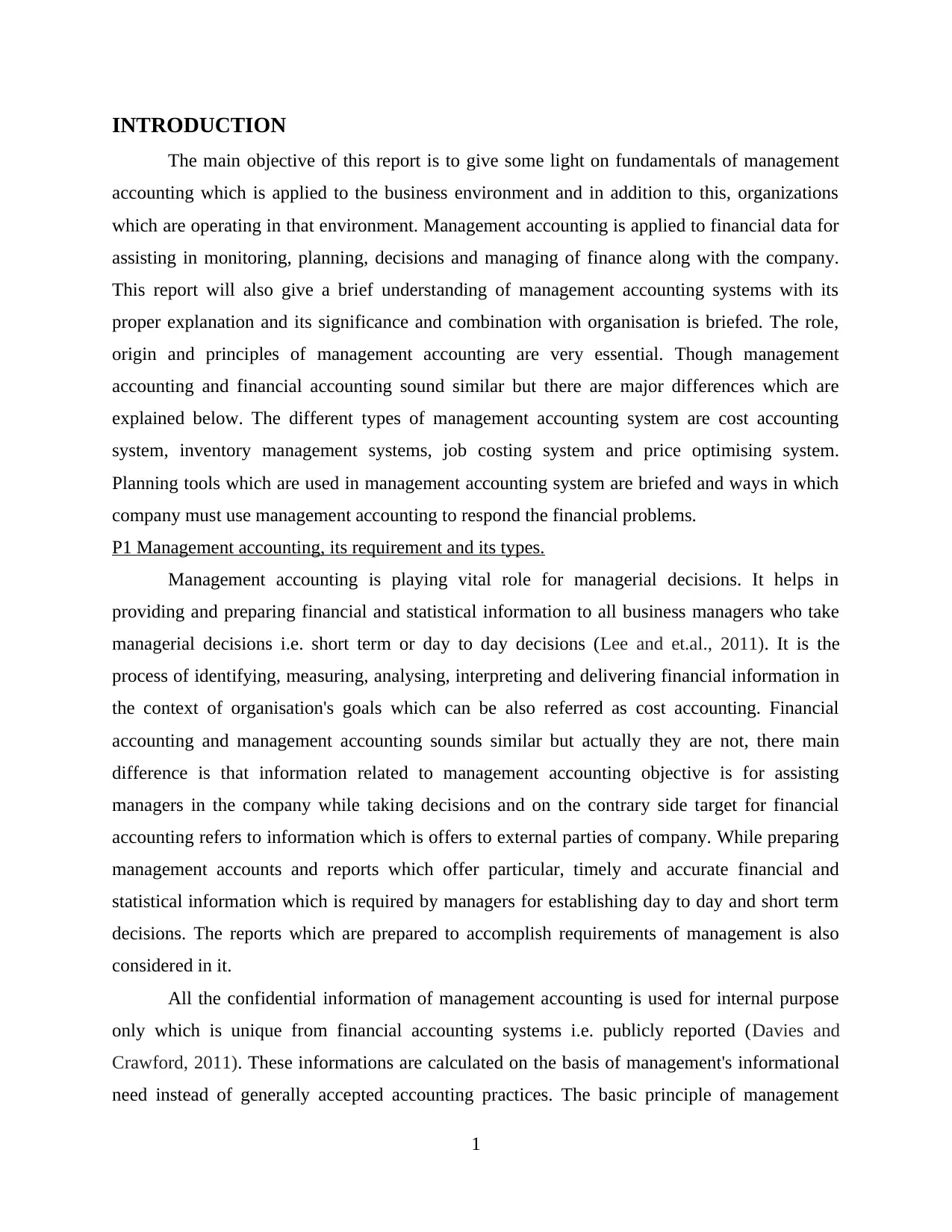
INTRODUCTION
The main objective of this report is to give some light on fundamentals of management
accounting which is applied to the business environment and in addition to this, organizations
which are operating in that environment. Management accounting is applied to financial data for
assisting in monitoring, planning, decisions and managing of finance along with the company.
This report will also give a brief understanding of management accounting systems with its
proper explanation and its significance and combination with organisation is briefed. The role,
origin and principles of management accounting are very essential. Though management
accounting and financial accounting sound similar but there are major differences which are
explained below. The different types of management accounting system are cost accounting
system, inventory management systems, job costing system and price optimising system.
Planning tools which are used in management accounting system are briefed and ways in which
company must use management accounting to respond the financial problems.
P1 Management accounting, its requirement and its types.
Management accounting is playing vital role for managerial decisions. It helps in
providing and preparing financial and statistical information to all business managers who take
managerial decisions i.e. short term or day to day decisions (Lee and et.al., 2011). It is the
process of identifying, measuring, analysing, interpreting and delivering financial information in
the context of organisation's goals which can be also referred as cost accounting. Financial
accounting and management accounting sounds similar but actually they are not, there main
difference is that information related to management accounting objective is for assisting
managers in the company while taking decisions and on the contrary side target for financial
accounting refers to information which is offers to external parties of company. While preparing
management accounts and reports which offer particular, timely and accurate financial and
statistical information which is required by managers for establishing day to day and short term
decisions. The reports which are prepared to accomplish requirements of management is also
considered in it.
All the confidential information of management accounting is used for internal purpose
only which is unique from financial accounting systems i.e. publicly reported (Davies and
Crawford, 2011). These informations are calculated on the basis of management's informational
need instead of generally accepted accounting practices. The basic principle of management
1
The main objective of this report is to give some light on fundamentals of management
accounting which is applied to the business environment and in addition to this, organizations
which are operating in that environment. Management accounting is applied to financial data for
assisting in monitoring, planning, decisions and managing of finance along with the company.
This report will also give a brief understanding of management accounting systems with its
proper explanation and its significance and combination with organisation is briefed. The role,
origin and principles of management accounting are very essential. Though management
accounting and financial accounting sound similar but there are major differences which are
explained below. The different types of management accounting system are cost accounting
system, inventory management systems, job costing system and price optimising system.
Planning tools which are used in management accounting system are briefed and ways in which
company must use management accounting to respond the financial problems.
P1 Management accounting, its requirement and its types.
Management accounting is playing vital role for managerial decisions. It helps in
providing and preparing financial and statistical information to all business managers who take
managerial decisions i.e. short term or day to day decisions (Lee and et.al., 2011). It is the
process of identifying, measuring, analysing, interpreting and delivering financial information in
the context of organisation's goals which can be also referred as cost accounting. Financial
accounting and management accounting sounds similar but actually they are not, there main
difference is that information related to management accounting objective is for assisting
managers in the company while taking decisions and on the contrary side target for financial
accounting refers to information which is offers to external parties of company. While preparing
management accounts and reports which offer particular, timely and accurate financial and
statistical information which is required by managers for establishing day to day and short term
decisions. The reports which are prepared to accomplish requirements of management is also
considered in it.
All the confidential information of management accounting is used for internal purpose
only which is unique from financial accounting systems i.e. publicly reported (Davies and
Crawford, 2011). These informations are calculated on the basis of management's informational
need instead of generally accepted accounting practices. The basic principle of management
1
⊘ This is a preview!⊘
Do you want full access?
Subscribe today to unlock all pages.

Trusted by 1+ million students worldwide
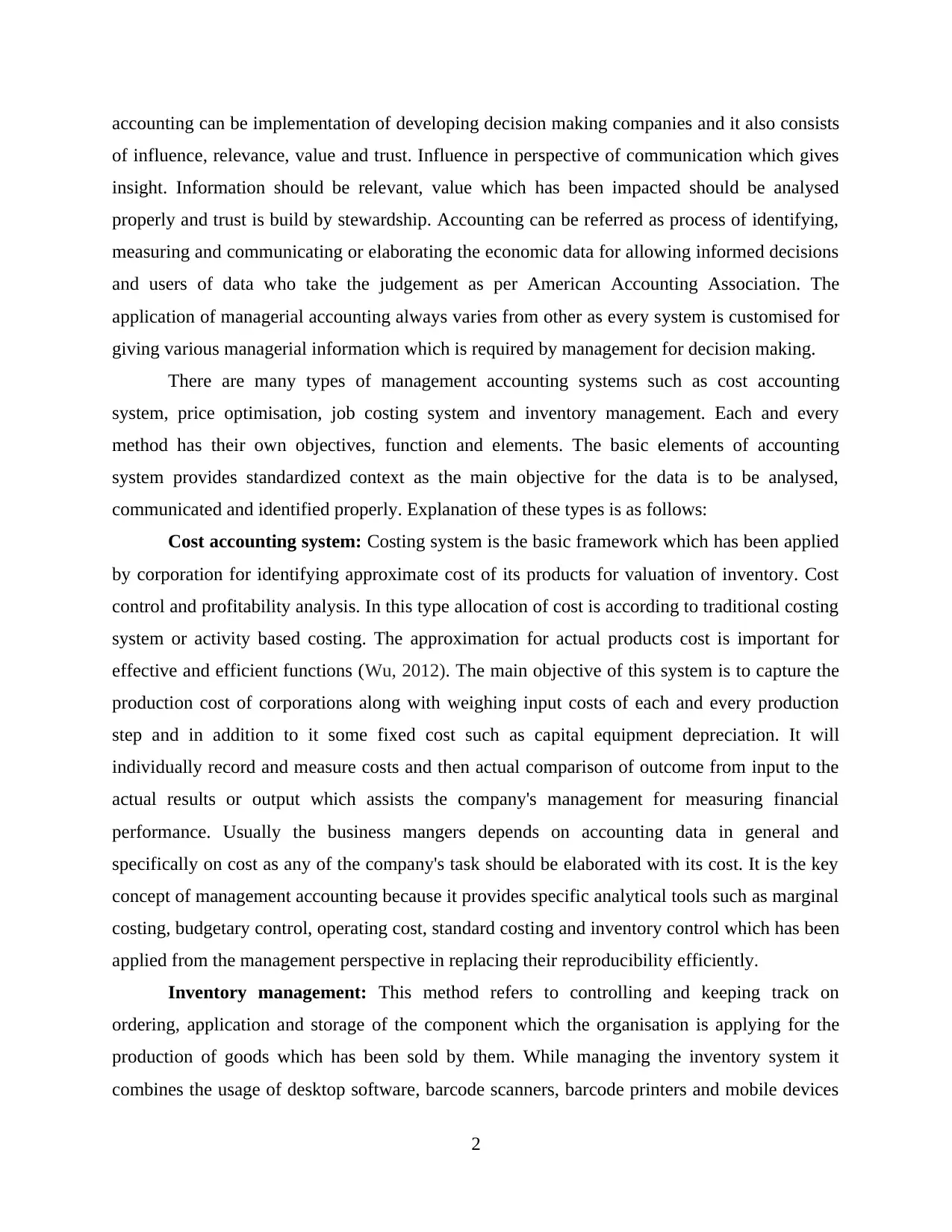
accounting can be implementation of developing decision making companies and it also consists
of influence, relevance, value and trust. Influence in perspective of communication which gives
insight. Information should be relevant, value which has been impacted should be analysed
properly and trust is build by stewardship. Accounting can be referred as process of identifying,
measuring and communicating or elaborating the economic data for allowing informed decisions
and users of data who take the judgement as per American Accounting Association. The
application of managerial accounting always varies from other as every system is customised for
giving various managerial information which is required by management for decision making.
There are many types of management accounting systems such as cost accounting
system, price optimisation, job costing system and inventory management. Each and every
method has their own objectives, function and elements. The basic elements of accounting
system provides standardized context as the main objective for the data is to be analysed,
communicated and identified properly. Explanation of these types is as follows:
Cost accounting system: Costing system is the basic framework which has been applied
by corporation for identifying approximate cost of its products for valuation of inventory. Cost
control and profitability analysis. In this type allocation of cost is according to traditional costing
system or activity based costing. The approximation for actual products cost is important for
effective and efficient functions (Wu, 2012). The main objective of this system is to capture the
production cost of corporations along with weighing input costs of each and every production
step and in addition to it some fixed cost such as capital equipment depreciation. It will
individually record and measure costs and then actual comparison of outcome from input to the
actual results or output which assists the company's management for measuring financial
performance. Usually the business mangers depends on accounting data in general and
specifically on cost as any of the company's task should be elaborated with its cost. It is the key
concept of management accounting because it provides specific analytical tools such as marginal
costing, budgetary control, operating cost, standard costing and inventory control which has been
applied from the management perspective in replacing their reproducibility efficiently.
Inventory management: This method refers to controlling and keeping track on
ordering, application and storage of the component which the organisation is applying for the
production of goods which has been sold by them. While managing the inventory system it
combines the usage of desktop software, barcode scanners, barcode printers and mobile devices
2
of influence, relevance, value and trust. Influence in perspective of communication which gives
insight. Information should be relevant, value which has been impacted should be analysed
properly and trust is build by stewardship. Accounting can be referred as process of identifying,
measuring and communicating or elaborating the economic data for allowing informed decisions
and users of data who take the judgement as per American Accounting Association. The
application of managerial accounting always varies from other as every system is customised for
giving various managerial information which is required by management for decision making.
There are many types of management accounting systems such as cost accounting
system, price optimisation, job costing system and inventory management. Each and every
method has their own objectives, function and elements. The basic elements of accounting
system provides standardized context as the main objective for the data is to be analysed,
communicated and identified properly. Explanation of these types is as follows:
Cost accounting system: Costing system is the basic framework which has been applied
by corporation for identifying approximate cost of its products for valuation of inventory. Cost
control and profitability analysis. In this type allocation of cost is according to traditional costing
system or activity based costing. The approximation for actual products cost is important for
effective and efficient functions (Wu, 2012). The main objective of this system is to capture the
production cost of corporations along with weighing input costs of each and every production
step and in addition to it some fixed cost such as capital equipment depreciation. It will
individually record and measure costs and then actual comparison of outcome from input to the
actual results or output which assists the company's management for measuring financial
performance. Usually the business mangers depends on accounting data in general and
specifically on cost as any of the company's task should be elaborated with its cost. It is the key
concept of management accounting because it provides specific analytical tools such as marginal
costing, budgetary control, operating cost, standard costing and inventory control which has been
applied from the management perspective in replacing their reproducibility efficiently.
Inventory management: This method refers to controlling and keeping track on
ordering, application and storage of the component which the organisation is applying for the
production of goods which has been sold by them. While managing the inventory system it
combines the usage of desktop software, barcode scanners, barcode printers and mobile devices
2
Paraphrase This Document
Need a fresh take? Get an instant paraphrase of this document with our AI Paraphraser
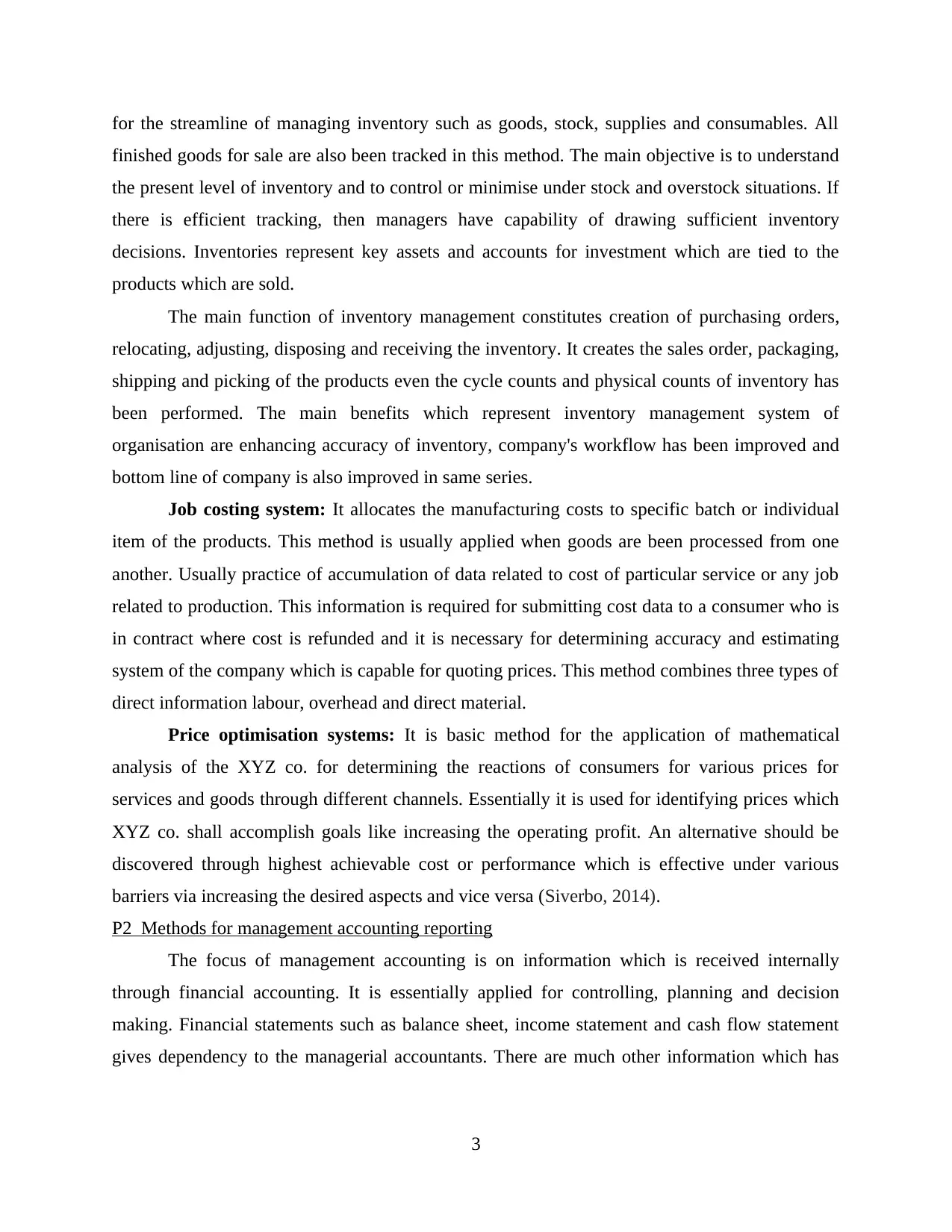
for the streamline of managing inventory such as goods, stock, supplies and consumables. All
finished goods for sale are also been tracked in this method. The main objective is to understand
the present level of inventory and to control or minimise under stock and overstock situations. If
there is efficient tracking, then managers have capability of drawing sufficient inventory
decisions. Inventories represent key assets and accounts for investment which are tied to the
products which are sold.
The main function of inventory management constitutes creation of purchasing orders,
relocating, adjusting, disposing and receiving the inventory. It creates the sales order, packaging,
shipping and picking of the products even the cycle counts and physical counts of inventory has
been performed. The main benefits which represent inventory management system of
organisation are enhancing accuracy of inventory, company's workflow has been improved and
bottom line of company is also improved in same series.
Job costing system: It allocates the manufacturing costs to specific batch or individual
item of the products. This method is usually applied when goods are been processed from one
another. Usually practice of accumulation of data related to cost of particular service or any job
related to production. This information is required for submitting cost data to a consumer who is
in contract where cost is refunded and it is necessary for determining accuracy and estimating
system of the company which is capable for quoting prices. This method combines three types of
direct information labour, overhead and direct material.
Price optimisation systems: It is basic method for the application of mathematical
analysis of the XYZ co. for determining the reactions of consumers for various prices for
services and goods through different channels. Essentially it is used for identifying prices which
XYZ co. shall accomplish goals like increasing the operating profit. An alternative should be
discovered through highest achievable cost or performance which is effective under various
barriers via increasing the desired aspects and vice versa (Siverbo, 2014).
P2 Methods for management accounting reporting
The focus of management accounting is on information which is received internally
through financial accounting. It is essentially applied for controlling, planning and decision
making. Financial statements such as balance sheet, income statement and cash flow statement
gives dependency to the managerial accountants. There are much other information which has
3
finished goods for sale are also been tracked in this method. The main objective is to understand
the present level of inventory and to control or minimise under stock and overstock situations. If
there is efficient tracking, then managers have capability of drawing sufficient inventory
decisions. Inventories represent key assets and accounts for investment which are tied to the
products which are sold.
The main function of inventory management constitutes creation of purchasing orders,
relocating, adjusting, disposing and receiving the inventory. It creates the sales order, packaging,
shipping and picking of the products even the cycle counts and physical counts of inventory has
been performed. The main benefits which represent inventory management system of
organisation are enhancing accuracy of inventory, company's workflow has been improved and
bottom line of company is also improved in same series.
Job costing system: It allocates the manufacturing costs to specific batch or individual
item of the products. This method is usually applied when goods are been processed from one
another. Usually practice of accumulation of data related to cost of particular service or any job
related to production. This information is required for submitting cost data to a consumer who is
in contract where cost is refunded and it is necessary for determining accuracy and estimating
system of the company which is capable for quoting prices. This method combines three types of
direct information labour, overhead and direct material.
Price optimisation systems: It is basic method for the application of mathematical
analysis of the XYZ co. for determining the reactions of consumers for various prices for
services and goods through different channels. Essentially it is used for identifying prices which
XYZ co. shall accomplish goals like increasing the operating profit. An alternative should be
discovered through highest achievable cost or performance which is effective under various
barriers via increasing the desired aspects and vice versa (Siverbo, 2014).
P2 Methods for management accounting reporting
The focus of management accounting is on information which is received internally
through financial accounting. It is essentially applied for controlling, planning and decision
making. Financial statements such as balance sheet, income statement and cash flow statement
gives dependency to the managerial accountants. There are much other information which has
3
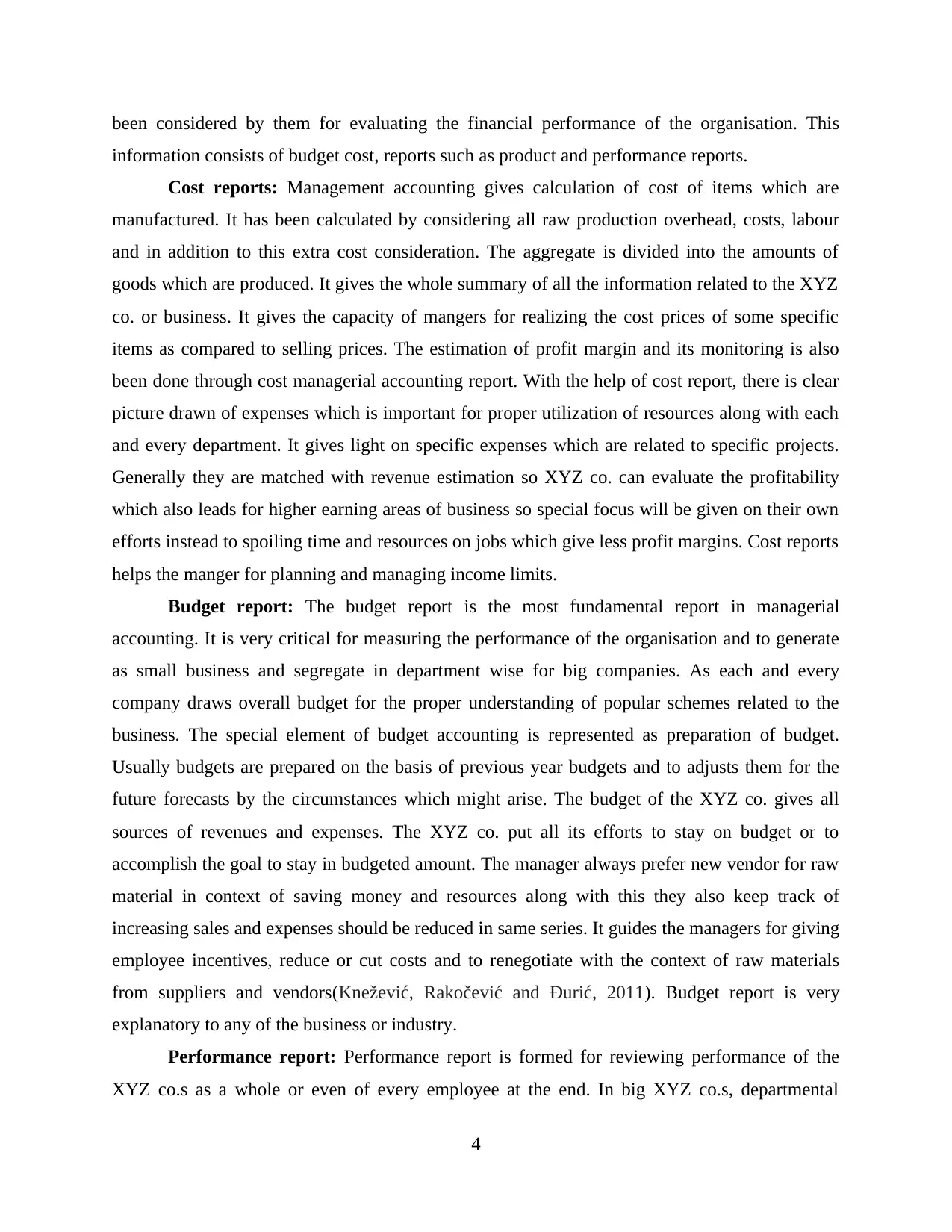
been considered by them for evaluating the financial performance of the organisation. This
information consists of budget cost, reports such as product and performance reports.
Cost reports: Management accounting gives calculation of cost of items which are
manufactured. It has been calculated by considering all raw production overhead, costs, labour
and in addition to this extra cost consideration. The aggregate is divided into the amounts of
goods which are produced. It gives the whole summary of all the information related to the XYZ
co. or business. It gives the capacity of mangers for realizing the cost prices of some specific
items as compared to selling prices. The estimation of profit margin and its monitoring is also
been done through cost managerial accounting report. With the help of cost report, there is clear
picture drawn of expenses which is important for proper utilization of resources along with each
and every department. It gives light on specific expenses which are related to specific projects.
Generally they are matched with revenue estimation so XYZ co. can evaluate the profitability
which also leads for higher earning areas of business so special focus will be given on their own
efforts instead to spoiling time and resources on jobs which give less profit margins. Cost reports
helps the manger for planning and managing income limits.
Budget report: The budget report is the most fundamental report in managerial
accounting. It is very critical for measuring the performance of the organisation and to generate
as small business and segregate in department wise for big companies. As each and every
company draws overall budget for the proper understanding of popular schemes related to the
business. The special element of budget accounting is represented as preparation of budget.
Usually budgets are prepared on the basis of previous year budgets and to adjusts them for the
future forecasts by the circumstances which might arise. The budget of the XYZ co. gives all
sources of revenues and expenses. The XYZ co. put all its efforts to stay on budget or to
accomplish the goal to stay in budgeted amount. The manager always prefer new vendor for raw
material in context of saving money and resources along with this they also keep track of
increasing sales and expenses should be reduced in same series. It guides the managers for giving
employee incentives, reduce or cut costs and to renegotiate with the context of raw materials
from suppliers and vendors(Knežević, Rakočević and Đurić, 2011). Budget report is very
explanatory to any of the business or industry.
Performance report: Performance report is formed for reviewing performance of the
XYZ co.s as a whole or even of every employee at the end. In big XYZ co.s, departmental
4
information consists of budget cost, reports such as product and performance reports.
Cost reports: Management accounting gives calculation of cost of items which are
manufactured. It has been calculated by considering all raw production overhead, costs, labour
and in addition to this extra cost consideration. The aggregate is divided into the amounts of
goods which are produced. It gives the whole summary of all the information related to the XYZ
co. or business. It gives the capacity of mangers for realizing the cost prices of some specific
items as compared to selling prices. The estimation of profit margin and its monitoring is also
been done through cost managerial accounting report. With the help of cost report, there is clear
picture drawn of expenses which is important for proper utilization of resources along with each
and every department. It gives light on specific expenses which are related to specific projects.
Generally they are matched with revenue estimation so XYZ co. can evaluate the profitability
which also leads for higher earning areas of business so special focus will be given on their own
efforts instead to spoiling time and resources on jobs which give less profit margins. Cost reports
helps the manger for planning and managing income limits.
Budget report: The budget report is the most fundamental report in managerial
accounting. It is very critical for measuring the performance of the organisation and to generate
as small business and segregate in department wise for big companies. As each and every
company draws overall budget for the proper understanding of popular schemes related to the
business. The special element of budget accounting is represented as preparation of budget.
Usually budgets are prepared on the basis of previous year budgets and to adjusts them for the
future forecasts by the circumstances which might arise. The budget of the XYZ co. gives all
sources of revenues and expenses. The XYZ co. put all its efforts to stay on budget or to
accomplish the goal to stay in budgeted amount. The manager always prefer new vendor for raw
material in context of saving money and resources along with this they also keep track of
increasing sales and expenses should be reduced in same series. It guides the managers for giving
employee incentives, reduce or cut costs and to renegotiate with the context of raw materials
from suppliers and vendors(Knežević, Rakočević and Đurić, 2011). Budget report is very
explanatory to any of the business or industry.
Performance report: Performance report is formed for reviewing performance of the
XYZ co.s as a whole or even of every employee at the end. In big XYZ co.s, departmental
4
⊘ This is a preview!⊘
Do you want full access?
Subscribe today to unlock all pages.

Trusted by 1+ million students worldwide
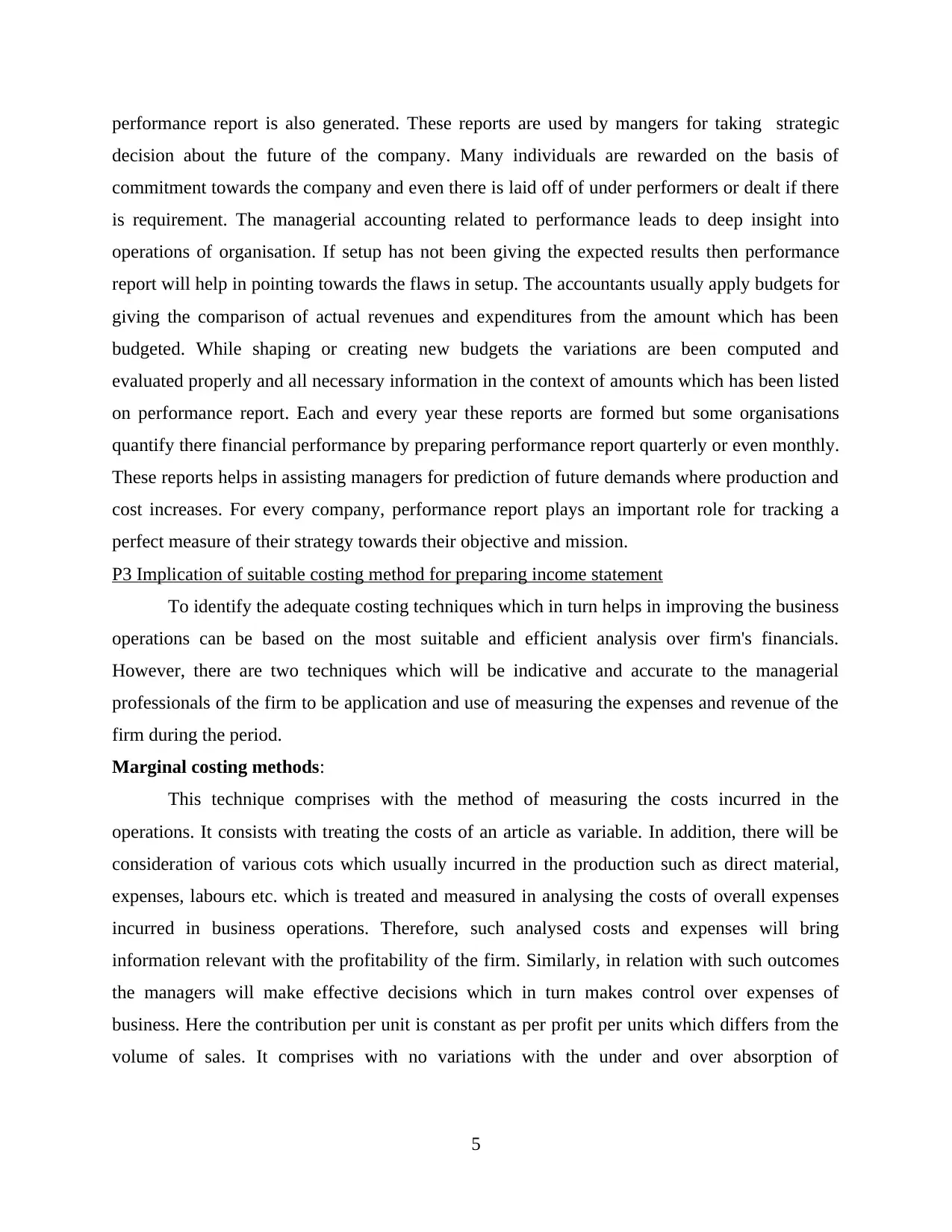
performance report is also generated. These reports are used by mangers for taking strategic
decision about the future of the company. Many individuals are rewarded on the basis of
commitment towards the company and even there is laid off of under performers or dealt if there
is requirement. The managerial accounting related to performance leads to deep insight into
operations of organisation. If setup has not been giving the expected results then performance
report will help in pointing towards the flaws in setup. The accountants usually apply budgets for
giving the comparison of actual revenues and expenditures from the amount which has been
budgeted. While shaping or creating new budgets the variations are been computed and
evaluated properly and all necessary information in the context of amounts which has been listed
on performance report. Each and every year these reports are formed but some organisations
quantify there financial performance by preparing performance report quarterly or even monthly.
These reports helps in assisting managers for prediction of future demands where production and
cost increases. For every company, performance report plays an important role for tracking a
perfect measure of their strategy towards their objective and mission.
P3 Implication of suitable costing method for preparing income statement
To identify the adequate costing techniques which in turn helps in improving the business
operations can be based on the most suitable and efficient analysis over firm's financials.
However, there are two techniques which will be indicative and accurate to the managerial
professionals of the firm to be application and use of measuring the expenses and revenue of the
firm during the period.
Marginal costing methods:
This technique comprises with the method of measuring the costs incurred in the
operations. It consists with treating the costs of an article as variable. In addition, there will be
consideration of various cots which usually incurred in the production such as direct material,
expenses, labours etc. which is treated and measured in analysing the costs of overall expenses
incurred in business operations. Therefore, such analysed costs and expenses will bring
information relevant with the profitability of the firm. Similarly, in relation with such outcomes
the managers will make effective decisions which in turn makes control over expenses of
business. Here the contribution per unit is constant as per profit per units which differs from the
volume of sales. It comprises with no variations with the under and over absorption of
5
decision about the future of the company. Many individuals are rewarded on the basis of
commitment towards the company and even there is laid off of under performers or dealt if there
is requirement. The managerial accounting related to performance leads to deep insight into
operations of organisation. If setup has not been giving the expected results then performance
report will help in pointing towards the flaws in setup. The accountants usually apply budgets for
giving the comparison of actual revenues and expenditures from the amount which has been
budgeted. While shaping or creating new budgets the variations are been computed and
evaluated properly and all necessary information in the context of amounts which has been listed
on performance report. Each and every year these reports are formed but some organisations
quantify there financial performance by preparing performance report quarterly or even monthly.
These reports helps in assisting managers for prediction of future demands where production and
cost increases. For every company, performance report plays an important role for tracking a
perfect measure of their strategy towards their objective and mission.
P3 Implication of suitable costing method for preparing income statement
To identify the adequate costing techniques which in turn helps in improving the business
operations can be based on the most suitable and efficient analysis over firm's financials.
However, there are two techniques which will be indicative and accurate to the managerial
professionals of the firm to be application and use of measuring the expenses and revenue of the
firm during the period.
Marginal costing methods:
This technique comprises with the method of measuring the costs incurred in the
operations. It consists with treating the costs of an article as variable. In addition, there will be
consideration of various cots which usually incurred in the production such as direct material,
expenses, labours etc. which is treated and measured in analysing the costs of overall expenses
incurred in business operations. Therefore, such analysed costs and expenses will bring
information relevant with the profitability of the firm. Similarly, in relation with such outcomes
the managers will make effective decisions which in turn makes control over expenses of
business. Here the contribution per unit is constant as per profit per units which differs from the
volume of sales. It comprises with no variations with the under and over absorption of
5
Paraphrase This Document
Need a fresh take? Get an instant paraphrase of this document with our AI Paraphraser
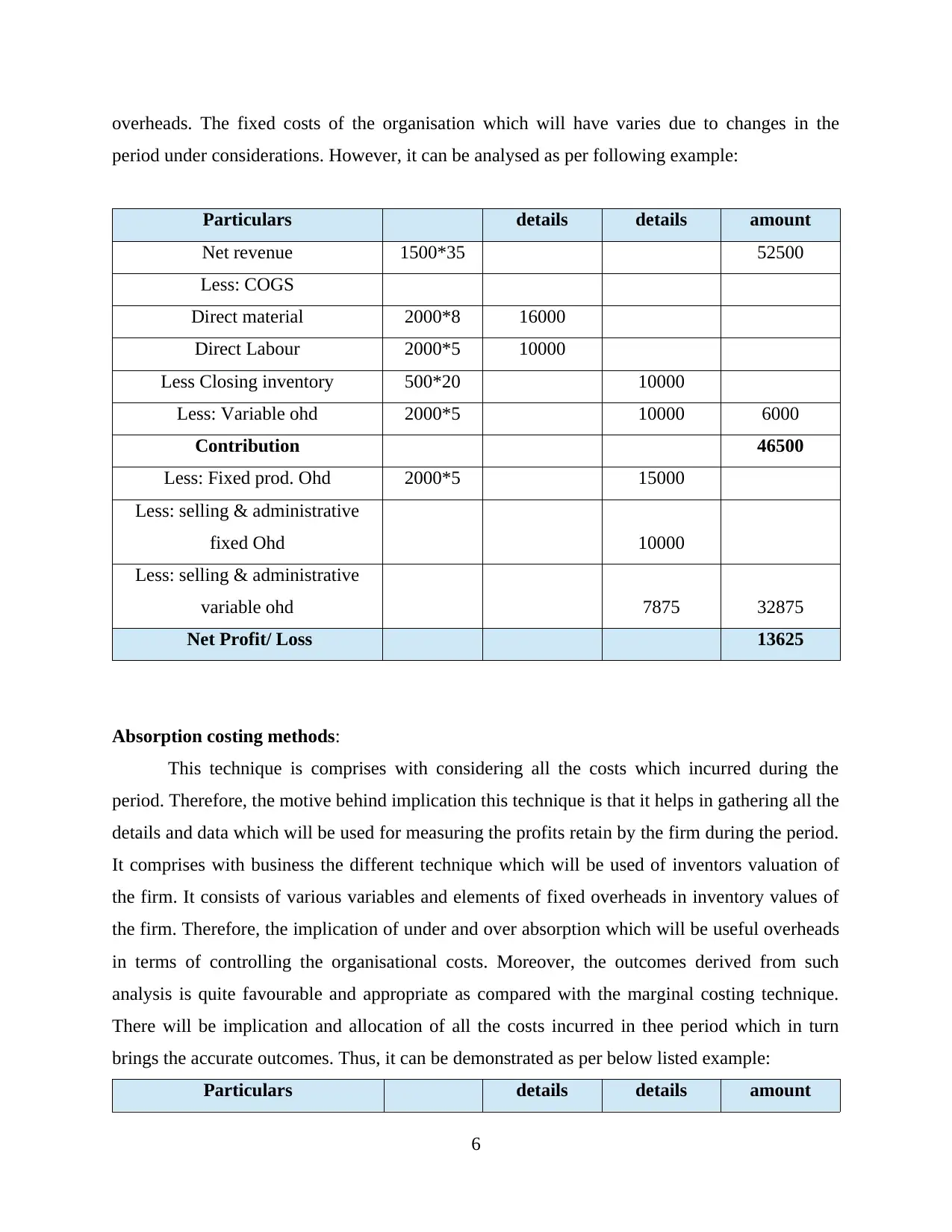
overheads. The fixed costs of the organisation which will have varies due to changes in the
period under considerations. However, it can be analysed as per following example:
Particulars details details amount
Net revenue 1500*35 52500
Less: COGS
Direct material 2000*8 16000
Direct Labour 2000*5 10000
Less Closing inventory 500*20 10000
Less: Variable ohd 2000*5 10000 6000
Contribution 46500
Less: Fixed prod. Ohd 2000*5 15000
Less: selling & administrative
fixed Ohd 10000
Less: selling & administrative
variable ohd 7875 32875
Net Profit/ Loss 13625
Absorption costing methods:
This technique is comprises with considering all the costs which incurred during the
period. Therefore, the motive behind implication this technique is that it helps in gathering all the
details and data which will be used for measuring the profits retain by the firm during the period.
It comprises with business the different technique which will be used of inventors valuation of
the firm. It consists of various variables and elements of fixed overheads in inventory values of
the firm. Therefore, the implication of under and over absorption which will be useful overheads
in terms of controlling the organisational costs. Moreover, the outcomes derived from such
analysis is quite favourable and appropriate as compared with the marginal costing technique.
There will be implication and allocation of all the costs incurred in thee period which in turn
brings the accurate outcomes. Thus, it can be demonstrated as per below listed example:
Particulars details details amount
6
period under considerations. However, it can be analysed as per following example:
Particulars details details amount
Net revenue 1500*35 52500
Less: COGS
Direct material 2000*8 16000
Direct Labour 2000*5 10000
Less Closing inventory 500*20 10000
Less: Variable ohd 2000*5 10000 6000
Contribution 46500
Less: Fixed prod. Ohd 2000*5 15000
Less: selling & administrative
fixed Ohd 10000
Less: selling & administrative
variable ohd 7875 32875
Net Profit/ Loss 13625
Absorption costing methods:
This technique is comprises with considering all the costs which incurred during the
period. Therefore, the motive behind implication this technique is that it helps in gathering all the
details and data which will be used for measuring the profits retain by the firm during the period.
It comprises with business the different technique which will be used of inventors valuation of
the firm. It consists of various variables and elements of fixed overheads in inventory values of
the firm. Therefore, the implication of under and over absorption which will be useful overheads
in terms of controlling the organisational costs. Moreover, the outcomes derived from such
analysis is quite favourable and appropriate as compared with the marginal costing technique.
There will be implication and allocation of all the costs incurred in thee period which in turn
brings the accurate outcomes. Thus, it can be demonstrated as per below listed example:
Particulars details details amount
6
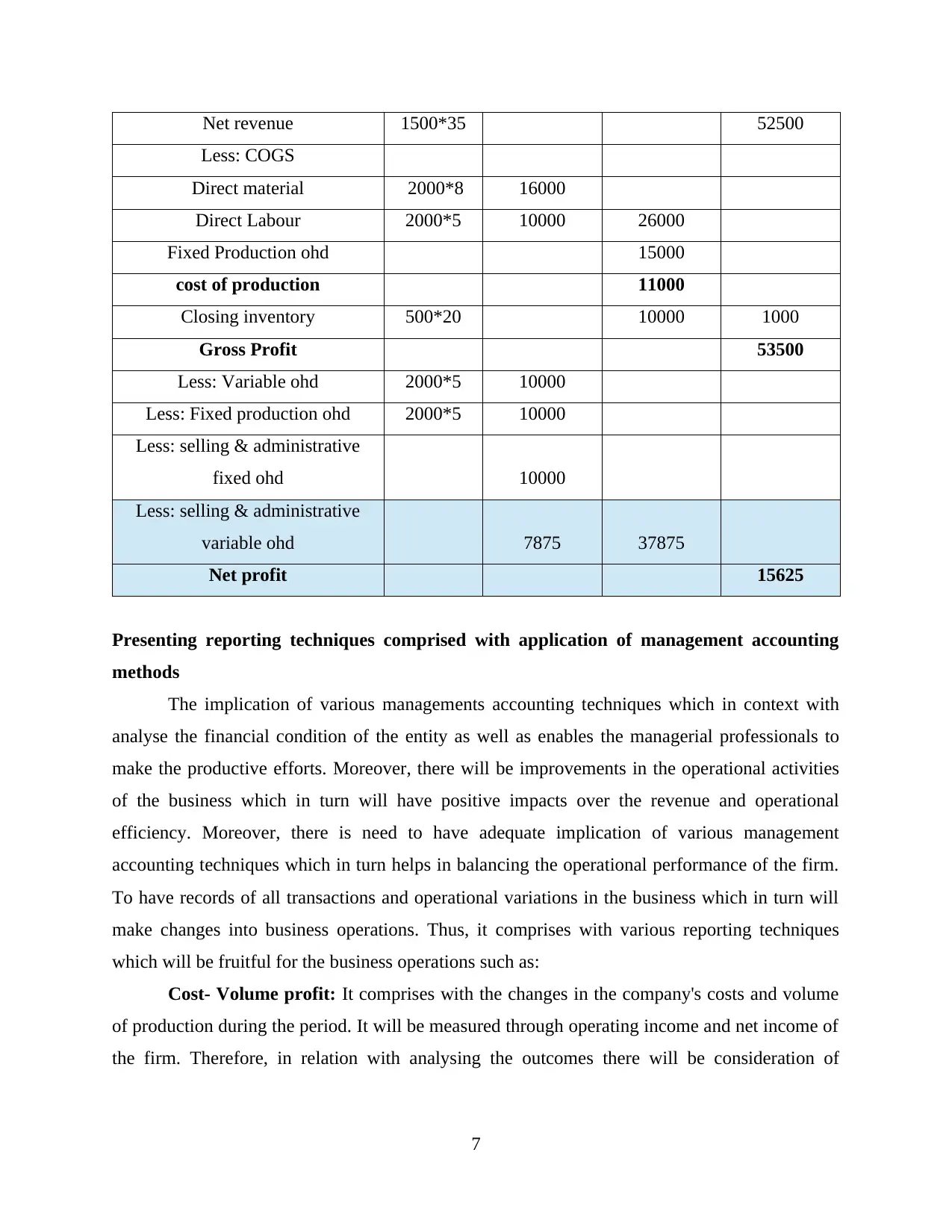
Net revenue 1500*35 52500
Less: COGS
Direct material 2000*8 16000
Direct Labour 2000*5 10000 26000
Fixed Production ohd 15000
cost of production 11000
Closing inventory 500*20 10000 1000
Gross Profit 53500
Less: Variable ohd 2000*5 10000
Less: Fixed production ohd 2000*5 10000
Less: selling & administrative
fixed ohd 10000
Less: selling & administrative
variable ohd 7875 37875
Net profit 15625
Presenting reporting techniques comprised with application of management accounting
methods
The implication of various managements accounting techniques which in context with
analyse the financial condition of the entity as well as enables the managerial professionals to
make the productive efforts. Moreover, there will be improvements in the operational activities
of the business which in turn will have positive impacts over the revenue and operational
efficiency. Moreover, there is need to have adequate implication of various management
accounting techniques which in turn helps in balancing the operational performance of the firm.
To have records of all transactions and operational variations in the business which in turn will
make changes into business operations. Thus, it comprises with various reporting techniques
which will be fruitful for the business operations such as:
Cost- Volume profit: It comprises with the changes in the company's costs and volume
of production during the period. It will be measured through operating income and net income of
the firm. Therefore, in relation with analysing the outcomes there will be consideration of
7
Less: COGS
Direct material 2000*8 16000
Direct Labour 2000*5 10000 26000
Fixed Production ohd 15000
cost of production 11000
Closing inventory 500*20 10000 1000
Gross Profit 53500
Less: Variable ohd 2000*5 10000
Less: Fixed production ohd 2000*5 10000
Less: selling & administrative
fixed ohd 10000
Less: selling & administrative
variable ohd 7875 37875
Net profit 15625
Presenting reporting techniques comprised with application of management accounting
methods
The implication of various managements accounting techniques which in context with
analyse the financial condition of the entity as well as enables the managerial professionals to
make the productive efforts. Moreover, there will be improvements in the operational activities
of the business which in turn will have positive impacts over the revenue and operational
efficiency. Moreover, there is need to have adequate implication of various management
accounting techniques which in turn helps in balancing the operational performance of the firm.
To have records of all transactions and operational variations in the business which in turn will
make changes into business operations. Thus, it comprises with various reporting techniques
which will be fruitful for the business operations such as:
Cost- Volume profit: It comprises with the changes in the company's costs and volume
of production during the period. It will be measured through operating income and net income of
the firm. Therefore, in relation with analysing the outcomes there will be consideration of
7
⊘ This is a preview!⊘
Do you want full access?
Subscribe today to unlock all pages.

Trusted by 1+ million students worldwide
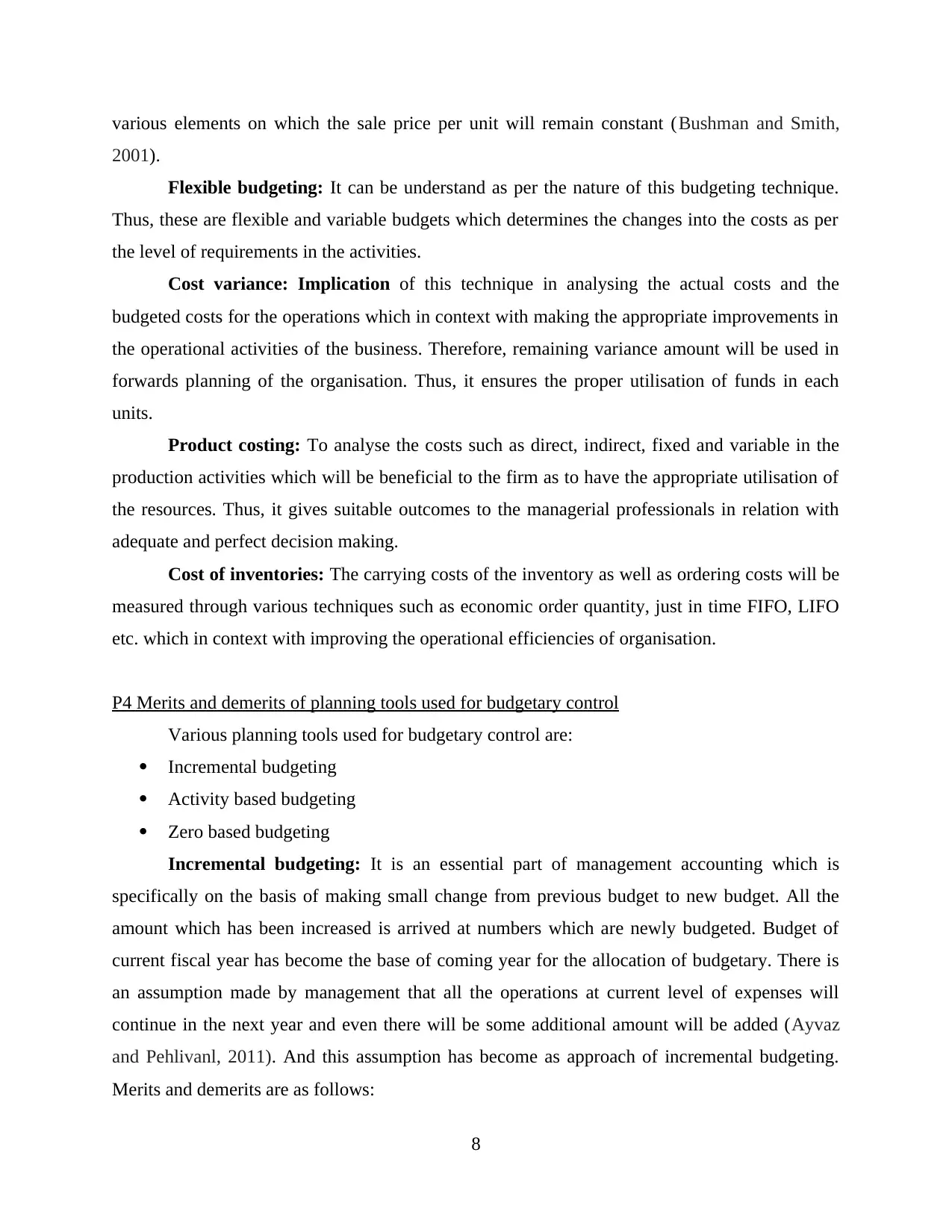
various elements on which the sale price per unit will remain constant (Bushman and Smith,
2001).
Flexible budgeting: It can be understand as per the nature of this budgeting technique.
Thus, these are flexible and variable budgets which determines the changes into the costs as per
the level of requirements in the activities.
Cost variance: Implication of this technique in analysing the actual costs and the
budgeted costs for the operations which in context with making the appropriate improvements in
the operational activities of the business. Therefore, remaining variance amount will be used in
forwards planning of the organisation. Thus, it ensures the proper utilisation of funds in each
units.
Product costing: To analyse the costs such as direct, indirect, fixed and variable in the
production activities which will be beneficial to the firm as to have the appropriate utilisation of
the resources. Thus, it gives suitable outcomes to the managerial professionals in relation with
adequate and perfect decision making.
Cost of inventories: The carrying costs of the inventory as well as ordering costs will be
measured through various techniques such as economic order quantity, just in time FIFO, LIFO
etc. which in context with improving the operational efficiencies of organisation.
P4 Merits and demerits of planning tools used for budgetary control
Various planning tools used for budgetary control are:
Incremental budgeting
Activity based budgeting
Zero based budgeting
Incremental budgeting: It is an essential part of management accounting which is
specifically on the basis of making small change from previous budget to new budget. All the
amount which has been increased is arrived at numbers which are newly budgeted. Budget of
current fiscal year has become the base of coming year for the allocation of budgetary. There is
an assumption made by management that all the operations at current level of expenses will
continue in the next year and even there will be some additional amount will be added (Ayvaz
and Pehlivanl, 2011). And this assumption has become as approach of incremental budgeting.
Merits and demerits are as follows:
8
2001).
Flexible budgeting: It can be understand as per the nature of this budgeting technique.
Thus, these are flexible and variable budgets which determines the changes into the costs as per
the level of requirements in the activities.
Cost variance: Implication of this technique in analysing the actual costs and the
budgeted costs for the operations which in context with making the appropriate improvements in
the operational activities of the business. Therefore, remaining variance amount will be used in
forwards planning of the organisation. Thus, it ensures the proper utilisation of funds in each
units.
Product costing: To analyse the costs such as direct, indirect, fixed and variable in the
production activities which will be beneficial to the firm as to have the appropriate utilisation of
the resources. Thus, it gives suitable outcomes to the managerial professionals in relation with
adequate and perfect decision making.
Cost of inventories: The carrying costs of the inventory as well as ordering costs will be
measured through various techniques such as economic order quantity, just in time FIFO, LIFO
etc. which in context with improving the operational efficiencies of organisation.
P4 Merits and demerits of planning tools used for budgetary control
Various planning tools used for budgetary control are:
Incremental budgeting
Activity based budgeting
Zero based budgeting
Incremental budgeting: It is an essential part of management accounting which is
specifically on the basis of making small change from previous budget to new budget. All the
amount which has been increased is arrived at numbers which are newly budgeted. Budget of
current fiscal year has become the base of coming year for the allocation of budgetary. There is
an assumption made by management that all the operations at current level of expenses will
continue in the next year and even there will be some additional amount will be added (Ayvaz
and Pehlivanl, 2011). And this assumption has become as approach of incremental budgeting.
Merits and demerits are as follows:
8
Paraphrase This Document
Need a fresh take? Get an instant paraphrase of this document with our AI Paraphraser
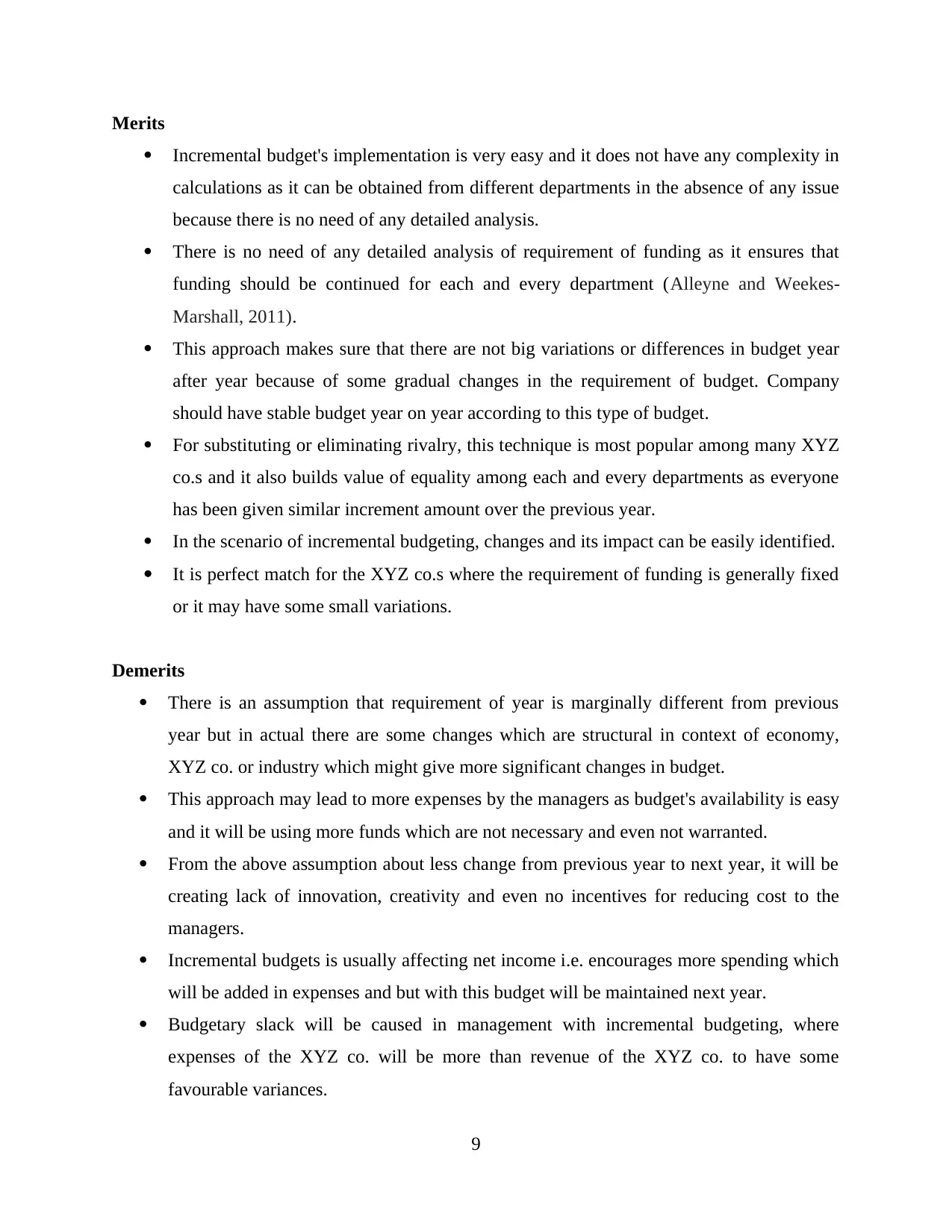
Merits
Incremental budget's implementation is very easy and it does not have any complexity in
calculations as it can be obtained from different departments in the absence of any issue
because there is no need of any detailed analysis.
There is no need of any detailed analysis of requirement of funding as it ensures that
funding should be continued for each and every department (Alleyne and Weekes-
Marshall, 2011).
This approach makes sure that there are not big variations or differences in budget year
after year because of some gradual changes in the requirement of budget. Company
should have stable budget year on year according to this type of budget.
For substituting or eliminating rivalry, this technique is most popular among many XYZ
co.s and it also builds value of equality among each and every departments as everyone
has been given similar increment amount over the previous year.
In the scenario of incremental budgeting, changes and its impact can be easily identified.
It is perfect match for the XYZ co.s where the requirement of funding is generally fixed
or it may have some small variations.
Demerits
There is an assumption that requirement of year is marginally different from previous
year but in actual there are some changes which are structural in context of economy,
XYZ co. or industry which might give more significant changes in budget.
This approach may lead to more expenses by the managers as budget's availability is easy
and it will be using more funds which are not necessary and even not warranted.
From the above assumption about less change from previous year to next year, it will be
creating lack of innovation, creativity and even no incentives for reducing cost to the
managers.
Incremental budgets is usually affecting net income i.e. encourages more spending which
will be added in expenses and but with this budget will be maintained next year.
Budgetary slack will be caused in management with incremental budgeting, where
expenses of the XYZ co. will be more than revenue of the XYZ co. to have some
favourable variances.
9
Incremental budget's implementation is very easy and it does not have any complexity in
calculations as it can be obtained from different departments in the absence of any issue
because there is no need of any detailed analysis.
There is no need of any detailed analysis of requirement of funding as it ensures that
funding should be continued for each and every department (Alleyne and Weekes-
Marshall, 2011).
This approach makes sure that there are not big variations or differences in budget year
after year because of some gradual changes in the requirement of budget. Company
should have stable budget year on year according to this type of budget.
For substituting or eliminating rivalry, this technique is most popular among many XYZ
co.s and it also builds value of equality among each and every departments as everyone
has been given similar increment amount over the previous year.
In the scenario of incremental budgeting, changes and its impact can be easily identified.
It is perfect match for the XYZ co.s where the requirement of funding is generally fixed
or it may have some small variations.
Demerits
There is an assumption that requirement of year is marginally different from previous
year but in actual there are some changes which are structural in context of economy,
XYZ co. or industry which might give more significant changes in budget.
This approach may lead to more expenses by the managers as budget's availability is easy
and it will be using more funds which are not necessary and even not warranted.
From the above assumption about less change from previous year to next year, it will be
creating lack of innovation, creativity and even no incentives for reducing cost to the
managers.
Incremental budgets is usually affecting net income i.e. encourages more spending which
will be added in expenses and but with this budget will be maintained next year.
Budgetary slack will be caused in management with incremental budgeting, where
expenses of the XYZ co. will be more than revenue of the XYZ co. to have some
favourable variances.
9
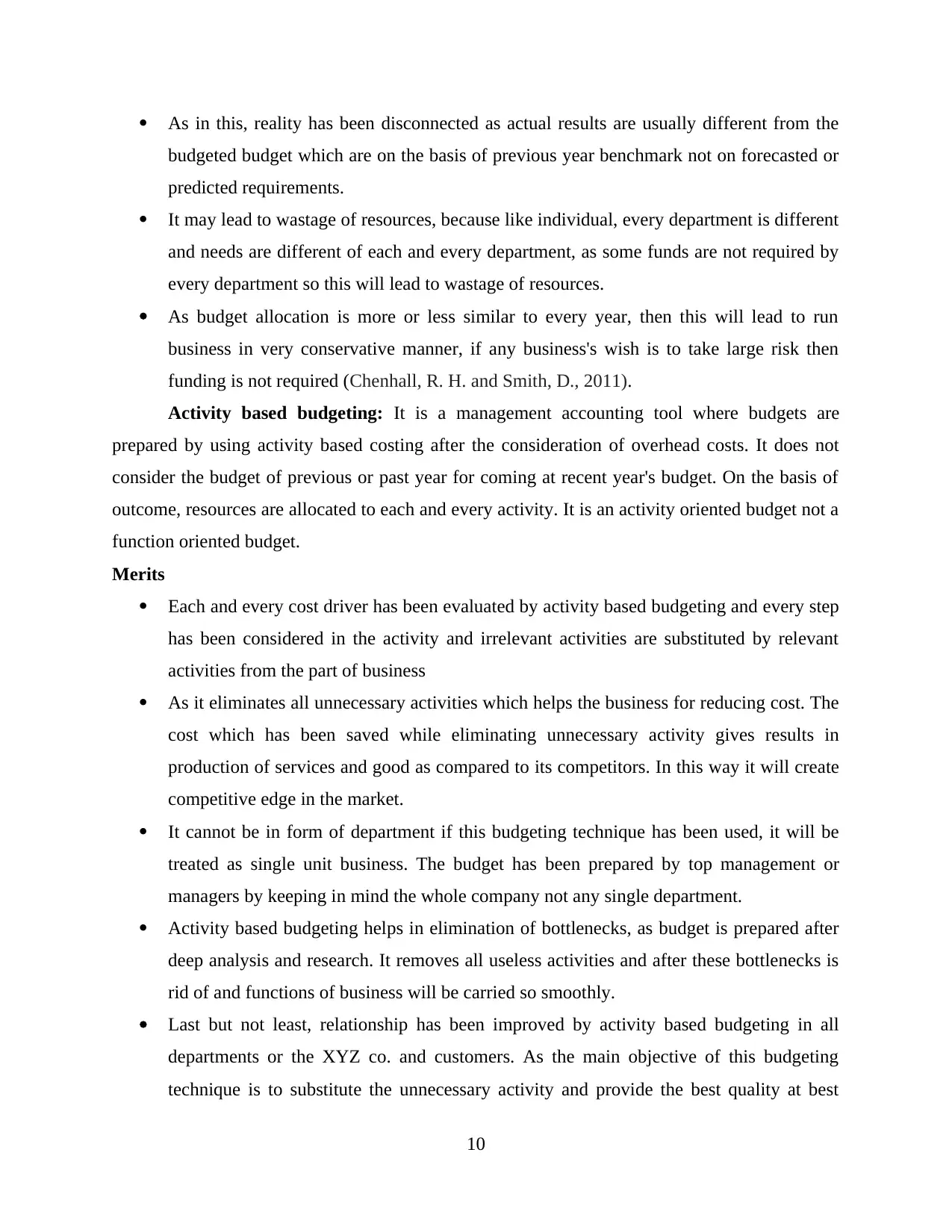
As in this, reality has been disconnected as actual results are usually different from the
budgeted budget which are on the basis of previous year benchmark not on forecasted or
predicted requirements.
It may lead to wastage of resources, because like individual, every department is different
and needs are different of each and every department, as some funds are not required by
every department so this will lead to wastage of resources.
As budget allocation is more or less similar to every year, then this will lead to run
business in very conservative manner, if any business's wish is to take large risk then
funding is not required (Chenhall, R. H. and Smith, D., 2011).
Activity based budgeting: It is a management accounting tool where budgets are
prepared by using activity based costing after the consideration of overhead costs. It does not
consider the budget of previous or past year for coming at recent year's budget. On the basis of
outcome, resources are allocated to each and every activity. It is an activity oriented budget not a
function oriented budget.
Merits
Each and every cost driver has been evaluated by activity based budgeting and every step
has been considered in the activity and irrelevant activities are substituted by relevant
activities from the part of business
As it eliminates all unnecessary activities which helps the business for reducing cost. The
cost which has been saved while eliminating unnecessary activity gives results in
production of services and good as compared to its competitors. In this way it will create
competitive edge in the market.
It cannot be in form of department if this budgeting technique has been used, it will be
treated as single unit business. The budget has been prepared by top management or
managers by keeping in mind the whole company not any single department.
Activity based budgeting helps in elimination of bottlenecks, as budget is prepared after
deep analysis and research. It removes all useless activities and after these bottlenecks is
rid of and functions of business will be carried so smoothly.
Last but not least, relationship has been improved by activity based budgeting in all
departments or the XYZ co. and customers. As the main objective of this budgeting
technique is to substitute the unnecessary activity and provide the best quality at best
10
budgeted budget which are on the basis of previous year benchmark not on forecasted or
predicted requirements.
It may lead to wastage of resources, because like individual, every department is different
and needs are different of each and every department, as some funds are not required by
every department so this will lead to wastage of resources.
As budget allocation is more or less similar to every year, then this will lead to run
business in very conservative manner, if any business's wish is to take large risk then
funding is not required (Chenhall, R. H. and Smith, D., 2011).
Activity based budgeting: It is a management accounting tool where budgets are
prepared by using activity based costing after the consideration of overhead costs. It does not
consider the budget of previous or past year for coming at recent year's budget. On the basis of
outcome, resources are allocated to each and every activity. It is an activity oriented budget not a
function oriented budget.
Merits
Each and every cost driver has been evaluated by activity based budgeting and every step
has been considered in the activity and irrelevant activities are substituted by relevant
activities from the part of business
As it eliminates all unnecessary activities which helps the business for reducing cost. The
cost which has been saved while eliminating unnecessary activity gives results in
production of services and good as compared to its competitors. In this way it will create
competitive edge in the market.
It cannot be in form of department if this budgeting technique has been used, it will be
treated as single unit business. The budget has been prepared by top management or
managers by keeping in mind the whole company not any single department.
Activity based budgeting helps in elimination of bottlenecks, as budget is prepared after
deep analysis and research. It removes all useless activities and after these bottlenecks is
rid of and functions of business will be carried so smoothly.
Last but not least, relationship has been improved by activity based budgeting in all
departments or the XYZ co. and customers. As the main objective of this budgeting
technique is to substitute the unnecessary activity and provide the best quality at best
10
⊘ This is a preview!⊘
Do you want full access?
Subscribe today to unlock all pages.

Trusted by 1+ million students worldwide
1 out of 19
Related Documents
Your All-in-One AI-Powered Toolkit for Academic Success.
+13062052269
info@desklib.com
Available 24*7 on WhatsApp / Email
![[object Object]](/_next/static/media/star-bottom.7253800d.svg)
Unlock your academic potential
Copyright © 2020–2025 A2Z Services. All Rights Reserved. Developed and managed by ZUCOL.





